Gliese 65, also known as Luyten 726-8, is a binary star system that is one of Earth's nearest neighbors, at 8.8 light-years from Earth in the constellation Cetus. The two component stars are both flare stars with the variable star designations BL Ceti and UV Ceti.
HD 114386 is a star with a pair of orbiting exoplanets in the southern constellation of Centaurus. It has an apparent visual magnitude of 8.73, which means it cannot be viewed with the naked eye but can be seen with a telescope or good binoculars. Based on parallax measurements, the system is located at a distance of 91 light years from the Sun. It is receding with a radial velocity of 33.4 km/s. The star shows a high proper motion, traversing the celestial sphere at an angular rate of 0.318 arcsec yr−1.
Struve 2398 is a binary star system in the northern constellation of Draco. Struve 2398 is star number 2398 in the Struve Double Star Catalog of Russian-German astronomer Friedrich Georg Wilhelm von Struve. The astronomer's surname, and hence the star identifier, is sometimes indicated by a Greek sigma, Σ; hence, this system can be listed with the identifier Σ 2398. Although the components are too faint to be viewed with the naked eye, this star system is among the closest to the Sun. Parallax measurements by the Gaia spacecraft give them an estimated distance of 11.5 light-years away.
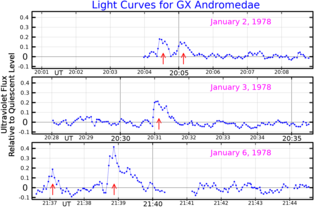
Groombridge 34 is a binary star system in the northern constellation of Andromeda. It was listed as entry number 34 in A Catalogue of Circumpolar Stars, published posthumously in 1838 by British astronomer Stephen Groombridge. Based upon parallax measurements taken by the Gaia spacecraft, the system is located about 11.6 light-years from the Sun. This positions the pair among the nearest stars to the Solar System.
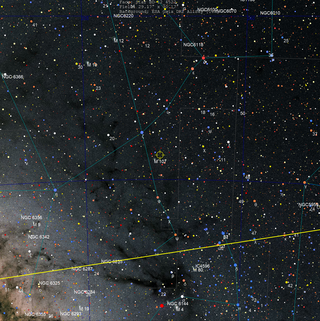
Wolf 1061 is an M-class red dwarf star located about 14.1 light-years away in the constellation Ophiuchus. It is the 36th-closest-known star system to the Sun and has a relatively high proper motion of 1.2 seconds of arc per year. Wolf 1061 does not have any unusual spectroscopic features.
TZ Arietis is a red dwarf in the northern constellation of Aries. With a normal apparent visual magnitude of 12.3, it is too faint to be seen by the naked eye, although it lies relatively close to the Sun at a distance of 14.6 light-years. It is a flare star, which means it can suddenly increase in brightness for short periods of time.
Gliese 674(GJ 674) is a small red dwarf star with an exoplanetary companion in the southern constellation of Ara. It is too faint to be visible to the naked eye, having an apparent visual magnitude of 9.38 and an absolute magnitude of 11.09. The system is located at a distance of 14.85 light-years from the Sun based on parallax measurements, but is drifting closer with a radial velocity of −2.9 km/s. It is a candidate member of the 200 million year old Castor stream of co-moving stars.
DENIS J1048−3956 is an exceptionally small, dim ultra-cool red dwarf star 13.2 light-years from Earth in the southern constellation of Antlia, among the stars closest to Earth. This star is very dim with an apparent magnitude of about 17, and requires a telescope with a camera to be seen. It was discovered in 2000 by Xavier Delfosse and Thierry Forveille, with the assistance of nine other astronomers.
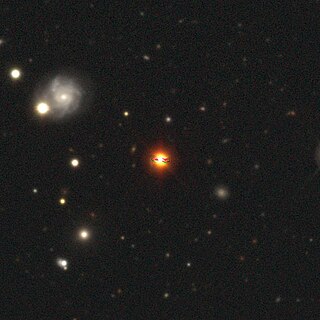
LP 944-20 is a dim brown dwarf of spectral class M9 located 21 light-years from the Solar System in the constellation of Fornax. With a visual apparent magnitude of 18.69, it has one of the dimmest visual magnitudes listed on the RECONS page. It is one of the brightest brown dwarfs, if not the brightest at JMKO=10.68±0.03 mag.

TVLM 513-46546 is an M9 ultracool dwarf at the red dwarf/brown dwarf mass boundary in the constellation Boötes. It exhibits flare star activity, which is most pronounced at radio wavelengths. The star has a mass approximately 80 times the mass of Jupiter. The radio emission is broadband and highly circularly polarized, similar to planetary auroral radio emissions. The radio emission is periodic, with bursts emitted every 7054 s, with nearly one hundredth of a second precision. Subtle variations in the radio pulses could suggest that the ultracool dwarf rotates faster at the equator than the poles in a manner similar to the Sun.
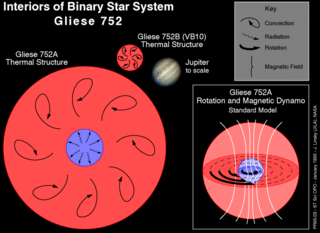
Gliese 752 is a binary star system in the Aquila constellation. This system is relatively nearby, at a distance of 19.3 light-years.
HD 126614 is a trinary star system in the equatorial constellation of Virgo. The primary member, designated component A, is host to an exoplanetary companion. With an apparent visual magnitude of 8.81, it is too faint to be seen with the naked eye. The system is located at a distance of 239 light years from the Sun based on parallax measurements, but is drifting closer with a radial velocity of −33 km/s.
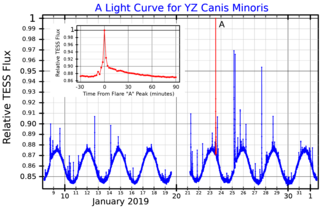
YZ Canis Minoris is a red-hued star in the equatorial constellation of Canis Minor. With an apparent visual magnitude of 11.15, it is much too faint to be viewed with the naked eye. The distance to YZ CMi can be estimated from its annual parallax shift of 167 mas, yielding a value of 19.5 light years. Presently the star is moving further away with a heliocentric radial velocity of +26.5 km/s. It made its closest approach some 162,000 years ago when it made perihelion passage at a distance of 10.2 ly. YZ CMi is a potential member of the Beta Pictoris moving group.

LSR J1835+3259 is a nearby ultracool dwarf of spectral class M8.5, located in constellation Lyra, the discovery of which was published in 2003. Previously it was concluded that this star is a young brown dwarf, but no lithium absorption lines are detected for this object, which is a strong indicator for young brown dwarfs that need 10-100 million years to deplete lithium.

Gliese 163 is a faint red dwarf star with multiple exoplanetary companions in the southern constellation of Dorado. Other stellar catalog names for it include HIP 19394 and LHS 188. It is too faint to be visible to the naked eye, having an apparent visual magnitude of 11.79 and an absolute magnitude of 10.91. This system is located at a distance of 49.4 light-years from the Sun based on parallax measurements. Judging by its space velocity components, it is most likely a thick disk star.

AZ Cancri (AZ Cnc) is a M-type flare star in the constellation Cancer. It has an apparent visual magnitude of approximately 17.59.
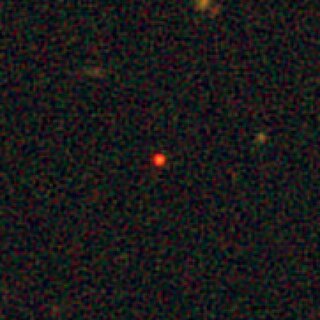
2MASS J03552337+1133437 is a nearby brown dwarf of spectral type L5γ, located in constellation Taurus at approximately 29.8 light-years from Earth.
GJ 3323 is a nearby single star located in the equatorial constellation Eridanus, about 0.4° to the northwest of the naked eye star Psi Eridani. It is invisible to the naked eye with an apparent visual magnitude 12.20. Parallax measurements give a distance estimate of 17.5 light-years from the Sun. It is drifting further away with a radial velocity of +42.3 km/s. Roughly 104,000 years ago, the star is believed to have come to within 7.34 ± 0.16 light-years of the Solar System.
GJ 1128 is a red dwarf star of spectral type M4.0V, located in constellation Carina 21 light-years away from Earth. It is one of the closer stars to the Sun.

LHS 1140 is a red dwarf in the constellation of Cetus. Based on stellar parallax measurement, it is 48.8 light-years away from the Sun. 'LHS' refers to the Luyten Half-Second Catalogue of stars with proper motions exceeding half a second of arc annually. The star is over 5 billion years old and has only about 18% the mass of the Sun and 21% of its radius. LHS 1140's rotational period is 130 days. No flares have been observed.











